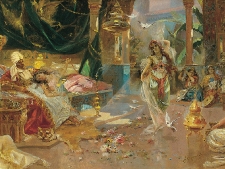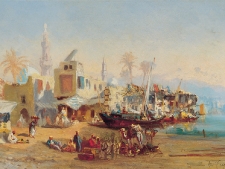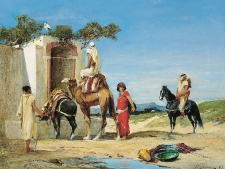
Du 18 mai au 31 décembre 2016 , le Musée Regards de Provence met à l’honneur l'Orientalisme à travers le regard d’artistes provençaux, italiens, espagnols ou algériens des XIXème et XXème siècles. Beauté et mystère de scènes historiques et exotiques d'un Orient réel ou phantasmé sont mis en lumière au travers de près de quatre-vingt tableaux et sculptures, issus de la collection Regards de Provence et de Musées.
Bompard, Brest, Chabaud, Clavère, Corrodi, Courdouan, Crapelet, Huguet, Lazergues, Le Gac, Loubon, Pascal, Philipoteaux, Rochegrosse, Silbert, Washington, Ziem et d'autres peignent Stamboul, Le Caire, Alger, les rives du Nil et les pyramides, le désert saharien, ses mystérieuses caravanes, ses puits, ses oueds et ses mirages. Des gardes nubiens au port noble aux pêcheurs dans leurs felouques au bord du Nil, des femmes luxueusement vêtues allongées dans leurs demeures aux musiciennes et danseuses dans le harem du Sultan, des bazars et marchands de tapis et objets d'art aux marchés grouillant de gens affairés et joyeux, sont autant d'invitations à l'évasion et au dépaysement.
Exceptionnellement, l'exposition sera fermée le mercredi 12 octobre à 16h30 et le jeudi 13 octobre, de 10h à 14h30.
From March 18 to December 31, the Musée Regards de Provence pays tribute to the Orientalist school of painting with a look at artists of different nationalities – Provencal, Italian, Spanish or Algerian – and working in different eras – the 19th, 20th and 21st centuries. Among those showcased – Bompard, Brest, Chabaud, Clavere, Corrodi Courdouan, Crapelet, Huguet, Lazergues, Le Gac, Loubon, Pascal, Philipoteaux, Rochegrosse, Silbert, Washington, Ziem. These creators lent their geniuses to representing Beauty and Mystery, and History. Their Orient – a place of reality or imagination appears in 84 pieces – paintings and sculptures – from the Fondation Regards de Provence collection and from other museums and private collections.
What is Orientalism and its chief components? It is the poems composed by Eastern « raconteurs » and sages, novels, tales of journeys and discoveries. Adventurous artists stricken by a sort of wanderlust to the exotic East drove and inspired the immensely popular Oriental style at the end of the 19th century.
Whether real or imaginary, physically explored or gleaned from the pages of a book, the mythical Orient inspired those fascinated by the concept to pushed back the boundaries of what was known to what was only imagined. The Levantine of old expanded its limits to encompass Egypt, Syria, Lebanon, Palestine and most of all Constantinople, capital of the ancient Byzantine Empire.
The Orientalists had a passion for the brilliance of colors and the flamboyance of sun light which they reproduced in a strictly academic style or taking avant-gardiste liberties with that style. They portrayed harems, street scenes, cool and dark interiors, landscapes, scenes of clamor or, secretiveness. Their works make use of vivid colors, they show floods of sunlight, or, to the contrary they opt for the strange, the lascivious, the tender, the ostentatious, the mysterious or the descriptive. Their art draws us like a magnet although our fascination is experienced, today, in a totally different way. The unifying factor which travels through the ages is the need to experience the unknown or the exotic, which remains one of the West’s remarkable characteristics.







